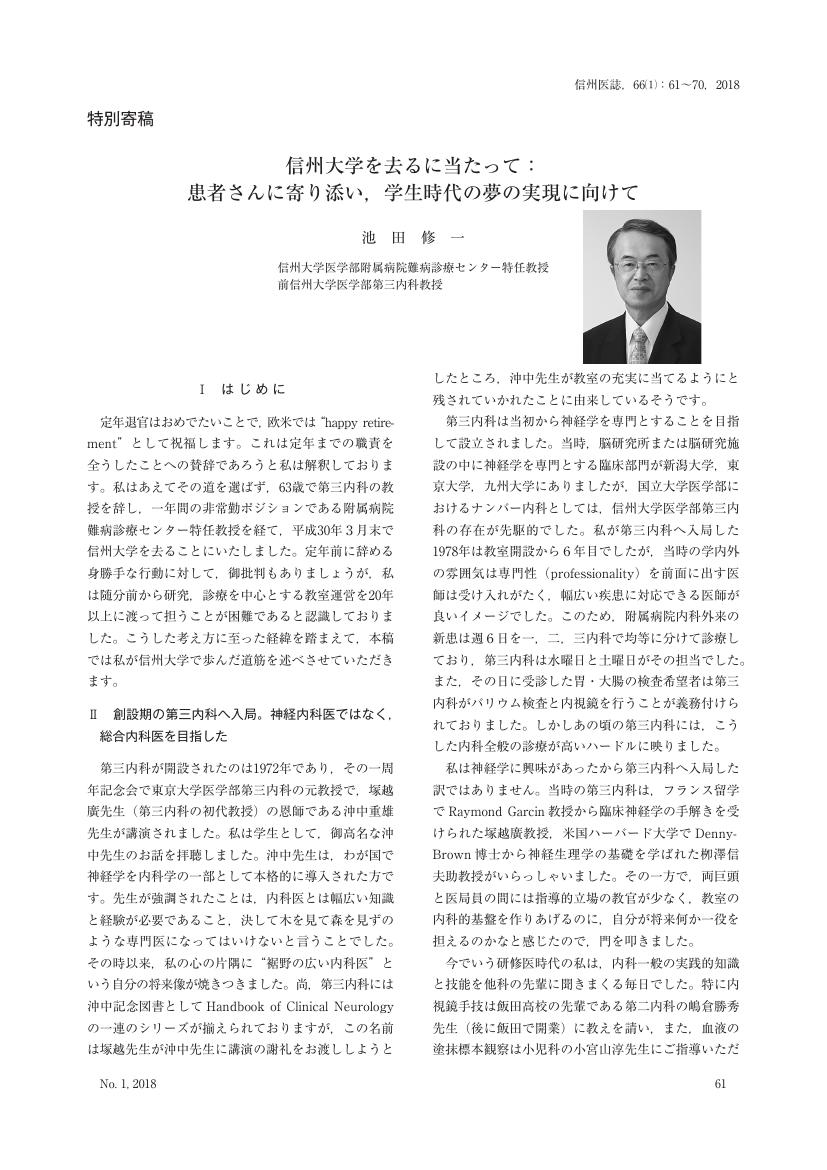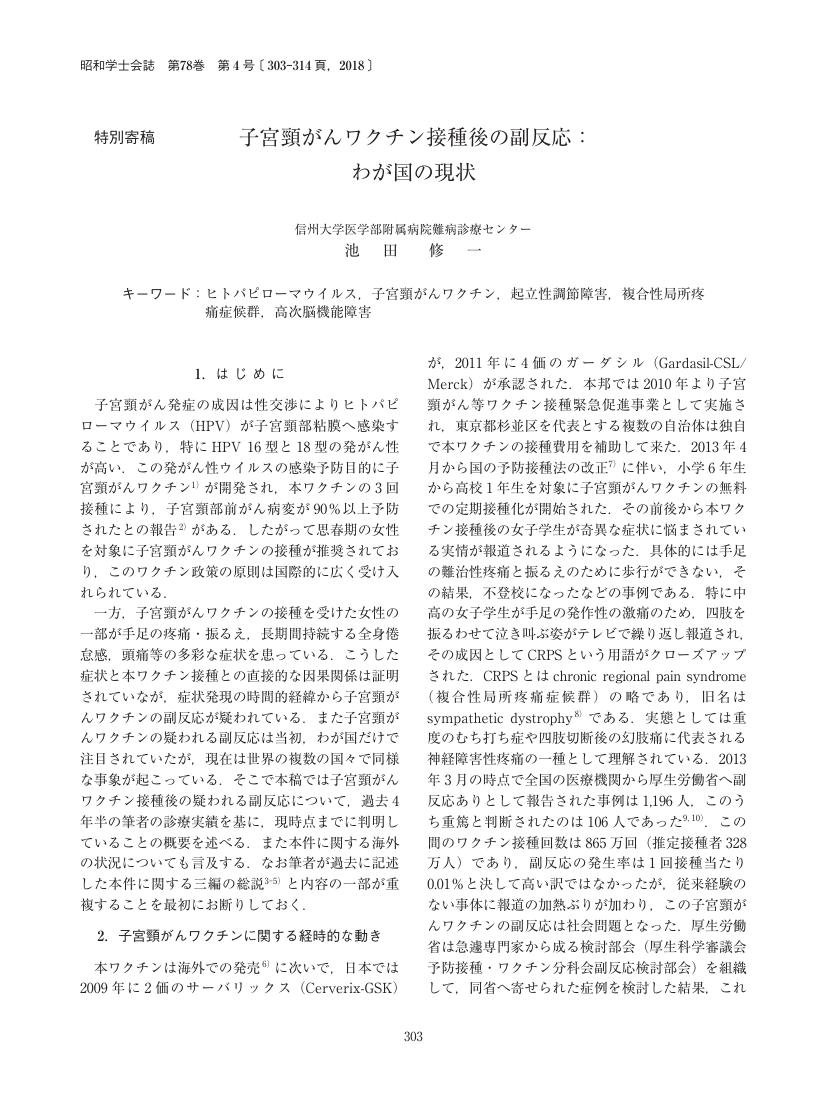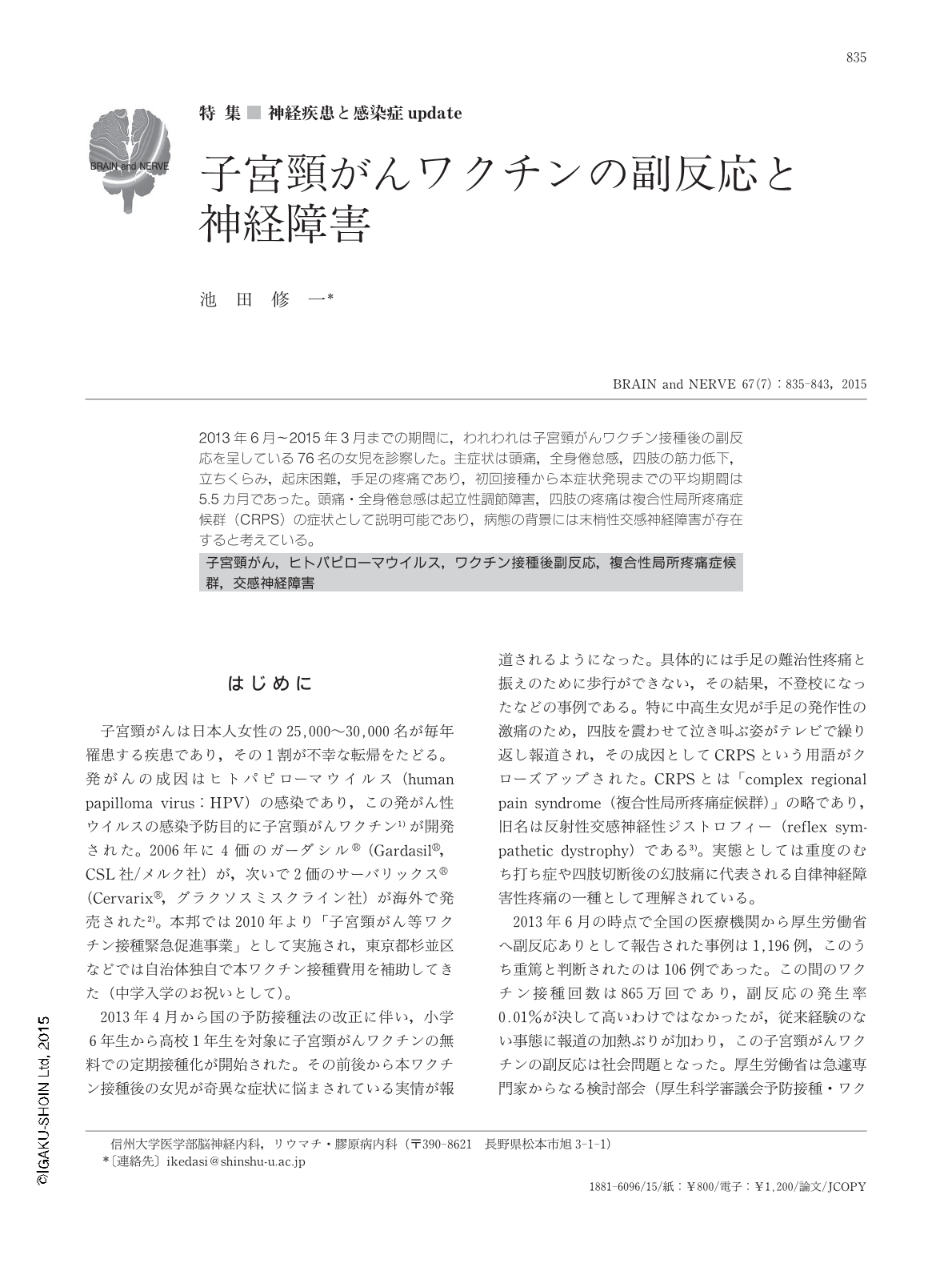489 0 0 0 OA 子宮頸がんワクチン関連の神経症候とその病態
- 著者
- 池田 修一
- 出版者
- 日本神経治療学会
- 雑誌
- 神経治療学 (ISSN:09168443)
- 巻号頁・発行日
- vol.33, no.1, pp.32-39, 2016 (Released:2016-05-20)
- 参考文献数
- 25
- 被引用文献数
- 2
A relatively high incidence of chronic limb pain, frequently complicated by violent, tremulous involuntary movements, has been noted in Japanese girls following human papillomavirus (HPV) vaccination. The average incubation period after the first dose of the vaccine was 5.47±5.00 months. Frequent manifestations included headaches, general fatigue, coldness of the legs, limb pain and weakness. The skin temperature examined in the girls with limb symptoms exhibited a slight decrease in the fingers and a moderate decrease in the toes. Digital plethysmograms revealed a reduced height of the waves, especially in the toes. The limb symptoms of the affected girls were compatible with the diagnostic criteria for complex regional pain syndrome (CRPS). The Schellong test identified a significant number of patients with orthostatic hypotension and a few patients with postural orthostatic tachycardia syndrome. Electron–microscopic examinations of the intradermal nerves showed an abnormal pathology in the unmyelinated fibers in two of the three girls examined. The symptoms observed in this study can be explained by abnormal peripheral sympathetic responses. The most common previous diagnosis in the studied girls was psychosomatic disease. Additionally delayed manifestation of cognitive dysfunction in the post–vaccinated girls has been paid much attention: memory loss, difficulty in reading textbooks and/or calculation.
233 0 0 0 OA 信州大学を去るに当たって:患者さんに寄り添い,学生時代の夢の実現に向けて
- 著者
- 池田 修一
- 出版者
- 信州医学会
- 雑誌
- 信州医学雑誌 (ISSN:00373826)
- 巻号頁・発行日
- vol.66, no.1, pp.61-70, 2018-02-10 (Released:2018-03-30)
170 0 0 0 OA 子宮頸がんワクチン接種後の副反応:
- 著者
- 池田 修一
- 出版者
- 昭和大学学士会
- 雑誌
- 昭和学士会雑誌 (ISSN:2187719X)
- 巻号頁・発行日
- vol.78, no.4, pp.303-314, 2018 (Released:2018-12-12)
- 参考文献数
- 56
46 0 0 0 子宮頸がんワクチンの副反応と神経障害
- 著者
- 池田 修一
- 出版者
- 医学書院
- 雑誌
- BRAIN and NERVE-神経研究の進歩 (ISSN:18816096)
- 巻号頁・発行日
- vol.67, no.7, pp.835-843, 2015-07-01
2013年6月〜2015年3月までの期間に,われわれは子宮頸がんワクチン接種後の副反応を呈している76名の女児を診察した。主症状は頭痛,全身倦怠感,四肢の筋力低下,立ちくらみ,起床困難,手足の疼痛であり,初回接種から本症状発現までの平均期間は5.5カ月であった。頭痛・全身倦怠感は起立性調節障害,四肢の疼痛は複合性局所疼痛症候群(CRPS)の症状として説明可能であり,病態の背景には末梢性交感神経障害が存在すると考えている。
6 0 0 0 OA 抗NMDAR脳炎における病的自己抗原提示細胞の検索研究
正常卵巣におけるNMDAR抗原の発現を検索するため、ウシの卵巣と未受精卵を検索した。免疫組織化学的に原始卵胞の細胞質と未受精卵の細胞膜にNR2B抗原の発現が認められた。次に凍結卵巣と未受精卵1031個を集めて蛋白化学的分析を行った。Immunoblottingではこれら組織にNR1とNR2Bの蛋白分画があることが見出された。そこで未受精卵の細胞膜から抽出した蛋白分画をLC-MS/MSで解析したところ、SPFGRFK, KNLQDR, GVEDALVSLK, QPTVAGAPK, NEVMSSKの5個のペプチドを得た。これらはNR1、NR2A、NR2B、NR2Cの部分アミノ酸配列と一致した。
2 0 0 0 OA 硬膜外麻酔併用全身麻酔後に発見された脊髄動静脈奇形の1症例
- 著者
- 鶴見 友子 大津 敏 池田 修 崎尾 秀彰
- 出版者
- 日本臨床麻酔学会
- 雑誌
- 日本臨床麻酔学会誌 (ISSN:02854945)
- 巻号頁・発行日
- vol.27, no.2, pp.176-181, 2007 (Released:2007-03-30)
- 参考文献数
- 16
- 被引用文献数
- 1 1
待機的胃癌手術に持続硬膜外麻酔併用全身麻酔を行ったところ, 術直後からTh10以下の感覚および運動神経麻痺を呈した症例を経験した. 術後の硬膜外造影で血腫は否定された. MRIおよび脊髄造影の所見から脊髄動静脈奇形 (arterio- venous malformation: AVM) と診断した. 胸髄完全麻痺のため, 外科的治療の適応がなく, 治療はメチルプレドニゾロンの大量投与とリハビリとなった. 2ヵ月後対麻痺が回復することはなく, 合併症の悪化により死亡した. あらかじめ無症候性の脊髄AVMを診断することは困難であるが, 硬膜外麻酔後に対麻痺が出現したときには留意すべき疾患の1つと考える.
- 著者
- 池田 修 佐伯 紘一 相部 保美
- 出版者
- 社団法人日本体育学会
- 雑誌
- 日本体育学会大会号
- 巻号頁・発行日
- no.29, 1978-12-17
2 0 0 0 OA 9世紀以前のアラビア語の研究
- 著者
- 池田 修
- 出版者
- 一般社団法人 日本オリエント学会
- 雑誌
- オリエント (ISSN:00305219)
- 巻号頁・発行日
- vol.11, no.3-4, pp.121-160,198, 1968 (Released:2010-03-12)
It is well known that the study of Arabic was carried on concurrently in Basra and Kufa, towns founded immediately after the Islamic conquest of Iraq.The development of these two cities was quite different. Basra, situated on the right bank of the Satt Al-crab, became one of the centers of world trade and has maintained its important position to the present. Kufa, on the other hand, played a major role in state adminstration at first, but lost its importance after the foundantion of Baghdad.The study of the Arabic flourished first in Basra, then in Kufa. Because of the controversy between the two towns the rules of the language were made from different viewpoints.The auther's intention is to examine the literary works of some of the famous scholars, thereby elucidating the differences between the Basra and Kufa schools. He concludes that the Basrans thought more logically and critically than the Kufans, establishing rigid rules which did not make exceptions for individual peculiarities. They used the so-called “qiyas” (analogy) system more strictly than did the Kufans.Although the Kufans began their studies with the “shuyukh” (masters) of Basra, they were soon expounding veiws which, more archaic and more natural, approved the individual exceptional styls (“shudhudh”) as a basis (“usul”) for further analogies. They were, so to speak, anomalists, while the Basrans were analogists.When Baghdad become the new intellectual center the controversy between the Basra and Kufa schools become more and more attenuated, finally disappearing in the 10th century. The residents of Baghdad chose between the rival doctrines by using both of them indiscriminately, thus representing electicism in the history of Arabic studies.
2 0 0 0 OA 自著とその周辺 視診・触診でわかる内科疾患の診かた
- 著者
- 池田 修一
- 出版者
- 信州医学会
- 雑誌
- 信州医学雑誌 (ISSN:00373826)
- 巻号頁・発行日
- vol.59, no.6, pp.448-448, 2011 (Released:2012-01-16)
1 0 0 0 OA 腕神経叢炎の病態と治療
- 著者
- 池田 修一
- 出版者
- 日本神経学会
- 雑誌
- 臨床神経学 (ISSN:0009918X)
- 巻号頁・発行日
- vol.53, no.11, pp.969-973, 2013-11-01 (Released:2013-11-29)
- 参考文献数
- 7
- 被引用文献数
- 6 6
神経痛性筋萎縮症(neuralgic amyotrophy; NA)は一側上肢に激烈な痛みに続いて麻痺と高度な筋萎縮が起る病態であり,その原因は特発性腕神経叢炎と考えられている.本疾患は従来,自然軽快することから予後良好であると位置付けられてきた.しかし罹患肢の実際の機能予後は半数以上が不良である.その最大の原因は確定診断にいたるまでの期間が長く,多くの患者は発病後2~3ヵ月後にやっとNAの診断が下されている.このため急性期の疼痛抑制治療,その後の運動機能改善に向けてのリハビリ治療などがほとんどなされていないのが実情である.本疾患が正確かつ早期に診断されるためには一般医家,とくにNA患者が最初に受診する可能性の高い整形外科領域の医師にNAの疾患概念を理解してもらうことである.またNA の成因として腕神経叢における免疫関連の末梢神経炎が推測されており,免疫調整療法は本疾患の有望な治療法になりうる.すでに副腎皮質ステロイドホルモンはNA急性期の疼痛緩和に有効なことが実証されている.それに加えてわれわれは免疫グロブリンの大量静注療法(IVIg)とステロイドパルス療法の併用がNAの運動麻痺に対して有用であることを最近提唱している.
1 0 0 0 OA 4.アミロイドーシス
- 著者
- 武井 洋一 池田 修一
- 出版者
- 一般社団法人 日本糖尿病学会
- 雑誌
- 糖尿病 (ISSN:0021437X)
- 巻号頁・発行日
- vol.58, no.8, pp.535-537, 2015-08-30 (Released:2015-08-30)
- 参考文献数
- 5
- 著者
- 池田 修
- 出版者
- 全国大学国語教育学会
- 雑誌
- 全国大学国語教育学会国語科教育研究:大会研究発表要旨集 126 (ISSN:24321753)
- 巻号頁・発行日
- pp.263-266, 2014-05-17 (Released:2020-07-15)
1 0 0 0 IR 「西爐の役」がもたらしたもの : 清朝の打箭爐支配成立の一側面
- 著者
- 池田 修太郎
- 出版者
- 立命館東洋史學會
- 雑誌
- 立命館東洋史學 = The journal of Ritsumeikan East Asian History Studies (ISSN:13451073)
- 巻号頁・発行日
- no.43, pp.1-50, 2020
1 0 0 0 OA 子宮頸がんワクチン接種後の副反応:わが国の現状
- 著者
- 池田 修一
- 出版者
- 昭和大学学士会
- 雑誌
- 昭和学士会雑誌 (ISSN:2187719X)
- 巻号頁・発行日
- vol.78, no.4, pp.303-314, 2018-08
1 0 0 0 OA 「西爐の役」がもたらしたもの:清朝の打箭爐支配成立の一側面
- 著者
- 池田 修太郎
- 出版者
- 立命館東洋史學會
- 雑誌
- 立命館東洋史学 (ISSN:13451073)
- 巻号頁・発行日
- vol.43, pp.1-50, 2020
1 0 0 0 OA UV照射によるPETの光劣化に対するITOの影響
- 著者
- 山浦 潔 伊藤 文就 池田 修 長谷川 匡俊
- 出版者
- 一般社団法人 日本接着学会
- 雑誌
- 日本接着学会誌 (ISSN:09164812)
- 巻号頁・発行日
- vol.44, no.3, pp.92-96, 2008-03-01 (Released:2014-06-30)
- 参考文献数
- 9
- 被引用文献数
- 1
汎用的樹脂ポリエチレンテレフタレート(PET)上にインジウム-錫酸化物(ITO)を被覆した導電性透明フィルムに紫外線を照射し,PETの劣化に対するITOの影響を調べた。試料は劣化による重量減少を示し,ITOで被覆されたPETフィルムの重量減少率はPETフィルム単独の場合を上回っていた。さらに,XPSの測定結果はITOとの界面でPETフィルムが分解している事を示した。両結果とも,ITOによる分解促進を示唆する結果である。また,可視紫外光の照射によるITO及びTiO2電極の電位変化を水溶液中で測定したところ,照射によって電極電位は両者とも卑電位方向に変化した。これらの結果から上述のPETの分解がITOの光触媒的な作用(酸化)である可能性がある。この作用を考慮し,エポキシ樹脂接着剤を用いて接着したITOと樹脂フィルムに紫外光照射を行ったところ,接着強度にもITOの影響が観察された。
1 0 0 0 IR 子宮頸がんワクチン接種後の副反応::わが国の現状
- 著者
- 池田 修一
- 出版者
- 昭和大学学士会
- 雑誌
- 昭和学士会雑誌 (ISSN:2187719X)
- 巻号頁・発行日
- vol.78, no.4, pp.303-314, 2018
1 0 0 0 子宮頸がんワクチン関連の神経症候とその病態
- 著者
- 池田 修一
- 出版者
- 日本神経治療学会
- 雑誌
- 神経治療学 (ISSN:09168443)
- 巻号頁・発行日
- vol.33, no.1, pp.32-39, 2016
A relatively high incidence of chronic limb pain, frequently complicated by violent, tremulous involuntary movements, has been noted in Japanese girls following human papillomavirus (HPV) vaccination. The average incubation period after the first dose of the vaccine was 5.47±5.00 months. Frequent manifestations included headaches, general fatigue, coldness of the legs, limb pain and weakness. The skin temperature examined in the girls with limb symptoms exhibited a slight decrease in the fingers and a moderate decrease in the toes. Digital plethysmograms revealed a reduced height of the waves, especially in the toes. The limb symptoms of the affected girls were compatible with the diagnostic criteria for complex regional pain syndrome (CRPS). The Schellong test identified a significant number of patients with orthostatic hypotension and a few patients with postural orthostatic tachycardia syndrome. Electron–microscopic examinations of the intradermal nerves showed an abnormal pathology in the unmyelinated fibers in two of the three girls examined. The symptoms observed in this study can be explained by abnormal peripheral sympathetic responses. The most common previous diagnosis in the studied girls was psychosomatic disease. Additionally delayed manifestation of cognitive dysfunction in the post–vaccinated girls has been paid much attention: memory loss, difficulty in reading textbooks and/or calculation.
1 0 0 0 国会と会計検査院を結ぶ
- 著者
- 池田 修
- 出版者
- 法曹会
- 雑誌
- 法曹時報 (ISSN:00239453)
- 巻号頁・発行日
- vol.41, no.3, pp.p930-944, 1989-03






